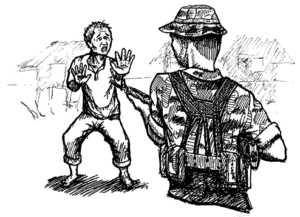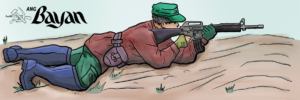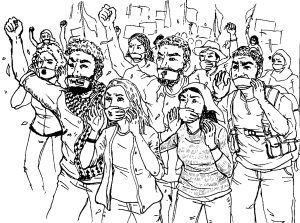by Ricardo Lozano and Raya Andres - Montanosa On Building the People’s Democratic Government
An interview with Marco Valbuena
Chief Information Officer of the Communist Party of the Philippines
Since the re-establishment of the Communist Party of the Philippines (CPP) on 26 December 1968, the concept of a People’s Democratic Government (PDG) and the eventual creation of the People’s Democratic Republic of the Philippines (PDRP) has always been a clear objective of the national democratic revolution.
In October 1972, the CPP issued the Guide to the Establishment of the People’s Democratic Government which outlined the basic principles and structures of people’s governance that would eventually form the PDG. One is also advised to read this document alongside the Revolutionary Guide to Land Reform which was released in 1971 by the CPP Central Committee.
But while the documents provide an aspirational overview of what the PDG could look like upon the victory of the national democratic revolution, the New People’s Army (NPA) led by the CPP is already constructing the basic building blocks of the PDG in the countryside – in the form of local organs of political power. To learn more about the local organs of political power and ongoing efforts of the CPP-NPA-NDF to build the PDG, we interviewed Marco Valbuena, Chief Information Officer of the CPP.
The PDG as the nucleus of the People’s Democratic Republic of the Philippines
When asked to define the PDG, Marco states that “the People’s Democratic Government is the emerging state representing the interests of workers, peasants, the petty bourgeoisie and national bourgeoisie and all democratic classes and sectors in the Philippines. It can be considered a united front government under the leadership of the working class.” According to the CPP, the basic unit of the PDG is the Barrio People’s Government which can take the form of the Barrio Revolutionary Committees (BRCs) in its rudimentary form. The PDG in turn is the nucleus of what would become the People’s Democratic Republic of the Philippines (PDRP).
Marco shares that the PDG “is presently in the embryonic stage taking the form of BRCs.” BRCs are formed by calling for barrio general assemblies which then elect officials to lead the functions of the PDG. These local organs of political power are currently being formed in thousands of villages in the revolutionary areas where the NPA operates under the leadership of the CPP.
The formation of BRCs in the countryside however requires a certain level of political development and capacity for self-defense. According to Marco, “the PDG, specifically the BRCs, are established on the basis of the organized strength of the masses. A village general assembly can be convened when majority of the people are organized in peasant associations, mass organizations of youth, women, and children, as well as cultural groups.” It is also important to note that BRCs can only exist in areas where agrarian revolution has reached sufficient achievements in line with the requirements set out in the Revolutionary Guide for Land Reform. Much of this depends on efforts to broaden and deepen the revolutionary mass bases in the countryside through waging agrarian revolution and developing guerilla warfare which is primarily carried out by the NPA.
In guerilla zones where BRCs exist, social services are implemented by BRC sub-committees responsible for economic production, health, education, culture, and defense. Within its capacity, and in coordination with local authorities of the Party and New People’s Army, the PDGs (BRCs) carry out economic, health, education and other services and mass campaigns. Because these are planned out by the people themselves, these programs address the specific needs in their villages.
Consistent with the NDFP’s 12-point program and the CPP’s program for the people’s democratic government, the PDG implements basic programs for the upliftment of women and children and the general improvement of community health. The care for geriatric and disabled people are part of the orientation of revolutionary health workers. Peasant associations can address the specific needs (economic support) of single parents, as well as households with disabled people, and martyrs or veterans of the people’s war.
“The welfare of the LGBTQ community is also addressed based on recognition of their status as a gender minority. There are instances when people’s organizations conduct educational discussions to raise their awareness and consciousness about the oppression and aspirations of the LGBTQ community, to address issues of discrimination and correct misconceptions,” Marco added.
Co-existence of PDG and GRP reflects the ‘fluid nature of the people’s war’
“The PDG or BRCs invariably exist alongside the barangay units of the reactionary government,” Marco explains. Indeed, in many areas in the countryside, barrio officials are either members of the BRC themselves or serve as conduits through which the policies of the BRC are carried out. Marco gives an example in the case of one BRC’s crop sharing policy which was implemented through a resolution issued by the barangay (basic government unit of the GRP).
In either case, the PDG operates in a clandestine manner in the current stage of the revolution. This is necessary to maintain secrecy and avoid attracting enemy reprisals. “This is a reflection of the fluid nature of the people’s war in the country in which there are no well-defined front and rear, and no definite borders between revolutionary areas and reactionary areas,” Marco adds.
According to Marco, “the New People’s Army can enter and operate at will in areas where the reactionary government exist, in the same way that the Armed Forces of the Philippines can enter and operate in revolutionary areas.”
At this point, the question of what happens to PDGs during intensive military operations becomes important to which Marco answers: “Through its committee on defense, the village PDG plans out the defense of communities by mobilizing the people, their militia units and self-defense corps, in coordination with territorial units of the New People’s Army. It secures the officers of the BRC and the structures of the village people’s government, who are targets of enemy counterinsurgency operations.”
Marco also shared how PDGs can coordinate with adjacent village PDGs to carry out “widespread guerilla warfare by mobilizing the entire population in order to mount tactical offensives using all possible weapons to fight and drive away the enemy from their communities.” At the same time, the PDGs have demonstrated their capacity to employ revolutionary dual tactics “by asserting their rights under the reactionary laws, and mounting mass actions to expose, denounce and put to task the enemy for their abuses and unlawful actions.”
The difference between the PDG and the GRP is ‘like night and day’
“The difference between the PDG and the current reactionary government (the Government of the Republic of the Philippines or GRP) is like night and day,” states Marco. The PDG represents the democratic rule of the toiling masses which is the complete opposite of how the GRP operates as “a dictatorship of the few exploiting classes” according to Marco.
To emphasize this difference, Marco explains that “under the PDG, the people exercise direct democracy and participate in the daily affairs of the state; while under the GRP, people’s participation is limited to electing ruling classes politicians in periodic pseudo-democratic elections. The armed forces of the GRP aim their weapons against the people, while under the PDG, weapons are in the people’s hands and used to defend their interests.”
Further to Marco’s point, the GRP under the current illegitimate president Marcos Jr professes subservience to US imperialist interests while serving the demands of big landlords, bourgeois compradors and bureaucrat capitalists. By way of example, the GRP has implemented a series of bogus land reforms from P.D. 27 to CARP meant to obscure their disinterest to pursue genuine land distribution. In contrast, the PDG “carries out land reform to address the main democratic demand of the majority of the Filipino people,” Marco emphasized.
Another point of departure between the reactionary GRP and the PDG is on the issue of corruption. The current Marcos-Duterte administration has recently been embroiled in a series of big corruption scandals from the railroading of the Maharlika Investment Fund (a.k.a. the motherlode of Marcos family corruption) and Sara Duterte’s confidential fund fiasco. In both instances, their use of the government machinery to rake profit from people’s money has been clearly exposed while they roam unscathed with impunity.
When asked how the PDG deals with ill-practices in daily governance, Marco shares that “supervision by the people is the key element.” Marco adds how “people’s assemblies which elect officials of the BRC to four-year terms have the power to cut short the term or replace their officials, or have their term extended. Those officials who are found to have used public resources for personal gain or have engaged in corrupt practices or other anti-people acts can be immediately removed from their positions, penalized or punished.”
The daily operations of the PDG are realized through the mobilization of the broad masses of the people “whether in fighting a militarily superior enemy force or turning idle land into productive fields.” Marco shares the process of how to inculcate a more progressive culture of democratic participation in governance compared to reactionary forms of government where citizens are considered as “passive” actors in the government. “The idea that the work of governance is the exclusive domain of officials must be unlearned and repudiated,” Marco said.
Marco admits that “not everything is smooth” when it comes to teaching the people the practice of democratic governance especially considering how the people’s government “is still engaged in war against the reactionary government.” He explains however that “the people have already made great achievements whether in fighting the enemy through armed struggle, or in fighting poverty, disease, social ills through their collective efforts.”
A clear example of this is how the PDGs in the form of BRCs responded to the Covid-19 pandemic. According to Marco, “during the pandemic and oppressive lockdowns, BRCs launched production campaigns to plant vegetables and other food crops to ensure food availability to community households.”
“Unlike programs of the reactionary government, programs carried out by the PDG are sustained because people themselves are empowered and shoulder the responsibility to carry the programs through,” he added.
On revolutionary taxation
Revolutionary taxation has been the subject of much controversy in recent years as the GRP continues to throw its old-age media spins of “unlawful extortion” or “terrorist financing” activities. But in reality, the PDG is the representation of a belligerent people’s government co-existing with the current reactionary state. Marco explains that “as a state, the PDG has the inherent right to collect taxes as a means of raising revenue to defray the costs of governance and public services.”
The PDG raises revenues from the economic production of its mass bases, and from the business operations within the scope and territory of the revolutionary government. Big businesses owned by allies of the PDG or by big bourgeois compradors and other class enemies are taxed based on their net profits and/or income. This process is guided mainly by united front principles “meaning, taxpayers are urged to pay for their dues by way of recognizing the political authority of the PDG,” according to Marco.
“The coercive use of arms is reserved as means of compelling business operations to follow environmental, labor, or other economic and social policies in areas where they are allowed to operate, or as way of penalizing them,” he added.
On revolutionary justice
“The PDG upholds a system of justice that protects the interests of the broad masses of the people against exploiters and oppressors,” says Marco. In the context of the Philippine countryside, the main source of injustice can be rooted in class contradictions between landlords and the peasant class.
Marco however explains that “the PDG differentiates conflicts or contradictions between the people and their enemies, and those contradictions among the people.” In cases of small inter-personal or other forms of minor disputes among the people, the PDG implements a system of arbitration to address such conflicts which can be settled through mutual agreement. “In fact, majority of cases involving the dispensation of justice by the BRCs are mostly settled through arbitration, in contrast to full trials,” Marco said.
The PDG implements revolutionary justice through a system of people’s courts which spans from the national down to the barrio level. The people’s court acts as the highest authority of justice at their level of governance by accepting complaints, carrying out investigations and holding trials or hearings. “For simpler cases a jury of at least three people can be formed to hear a case. For more complicated cases, especially if the possible penalty is capital punishment, a jury of at least nine people must be formed. Hearings are to be held publicly,” added Marco.
It is also important to note however that the armed agents of the reactionary state are also responsible for many forms of injustices as they commit atrocities against people’s civil and political rights during counterinsurgency operations. They too are subject to penalties and punishments meted out by the PDG.
The success of the PDG rests on the support of the masses
The PDG operates on many levels but at its most basic form, it could not exist without the support of the masses. Specifically, “the success of the PDG rests on the participation or mobilization of the peasant masses and national minorities, and its various strata and groups,” explains Marco.
This is a crucial point in the advance of the people’s democratic revolution and the continuing development of the PDG. By waging a broad antifeudal struggle, the peasant masses and national minorities can win over the middle and upper middle peasants and neutralize the rich peasants to isolate and defeat the power of the landed class.
Peasant associations must then consciously unite with other democratic forces under the leadership of proletarian revolutionary cadres. By linking the antifeudal struggle to the antifascist and antiimperialist fight, the advance of the people’s democratic revolution is ensured.




